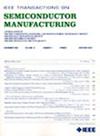Controlling Speckle Contrast Using Existing Lithographic Scanner Knobs to Explore the Impact on Line Width Roughness
IF 2.3
3区 工程技术
Q2 ENGINEERING, ELECTRICAL & ELECTRONIC
引用次数: 0
Abstract
Local critical dimension uniformity (LCDU) or line width roughness (LWR) is increasingly important in argon fluoride (ArF) immersion lithography systems (scanners) due to its growing contribution to edge placement error (EPE), an important parameter for circuit designers. A significant scanner contributor to LCDU is speckle, a light interference pattern that arises due to random coherent wavelet interference. In lithography systems (scanners), speckle will result in non-uniform dose delivery to the mask, causing local CD variations of the patterns imaged in the resist. This is an unwanted effect that potentially results in defects and should thus be controlled. In this work, existing lithographic scanner knobs are used to vary speckle contrast to showcase what product performance gain it can bring on LWR. This is achieved by slowing down the exposure speed, decreasing speckle contrast due to an increased number of pulses that fit in the exposure slit. However, this simultaneously brings scanner dynamics improvement that enhances imaging contrast which in turn also improves LWR. In order to decouple the dynamics and speckle improvement, additional experiments are required. This is done by restoring the speckle contrast for the slowed down exposures by adjusting the pulsed laser repetition rate. In the end, this series of experiments leads to a powerful framework to evaluate solely the speckle gain to product performance. In this work, the method is used to predict the LWR performance gain of the new ASML pulse stretcher which is designed to improve speckle contrast. Next to that, simulations are performed which accurately forecast the experimental results, demonstrating the robustness of the proposed framework. This work not only offers insights into optimizing the lithographic processes for improved product performance but also lays the groundwork for further exploration into scanner control strategies to minimize LWR and enhance yield in semiconductor manufacturing.利用现有光刻扫描仪旋钮控制散斑对比度,探讨对线宽粗糙度的影响
局部临界尺寸均匀性(LCDU)或线宽粗糙度(LWR)在氟化氩(ArF)浸没光刻系统(扫描仪)中越来越重要,因为它对边缘放置误差(EPE)的贡献越来越大,EPE是电路设计人员的一个重要参数。对LCDU有重要贡献的扫描器是散斑,一种由于随机相干小波干涉而产生的光干涉图案。在光刻系统(扫描仪)中,斑点将导致不均匀的剂量传递到掩模,导致在抗蚀剂中成像的图案的局部CD变化。这是一种不希望的效果,它可能导致缺陷,因此应该加以控制。在这项工作中,现有的光刻扫描仪旋钮用于改变散斑对比度,以展示它可以带来的低噪比产品性能增益。这是通过降低曝光速度来实现的,由于增加了适合曝光缝的脉冲数量,从而降低了散斑对比度。然而,这同时带来了扫描仪动态改进,增强了成像对比度,从而也提高了LWR。为了解耦动力学和改善散斑,需要进行额外的实验。这是通过调整脉冲激光重复率来恢复慢曝光的散斑对比度来实现的。最后,这一系列的实验产生了一个强大的框架来单独评估散斑增益对产品性能的影响。在这项工作中,该方法被用于预测新的ASML脉冲拉伸器的低波比性能增益,该脉冲拉伸器旨在提高散斑对比度。然后,进行了仿真,准确地预测了实验结果,证明了所提出框架的鲁棒性。这项工作不仅为优化光刻工艺以提高产品性能提供了见解,而且为进一步探索扫描仪控制策略奠定了基础,以最小化LWR并提高半导体制造的良率。
本文章由计算机程序翻译,如有差异,请以英文原文为准。
求助全文
约1分钟内获得全文
求助全文
来源期刊

IEEE Transactions on Semiconductor Manufacturing
工程技术-工程:电子与电气
CiteScore
5.20
自引率
11.10%
发文量
101
审稿时长
3.3 months
期刊介绍:
The IEEE Transactions on Semiconductor Manufacturing addresses the challenging problems of manufacturing complex microelectronic components, especially very large scale integrated circuits (VLSI). Manufacturing these products requires precision micropatterning, precise control of materials properties, ultraclean work environments, and complex interactions of chemical, physical, electrical and mechanical processes.
 求助内容:
求助内容: 应助结果提醒方式:
应助结果提醒方式:


